Suchergebnisse
Digitale Transformation der österreichischen Bauwirtschaft und Auswirkungen auf die Erwerbstätigen
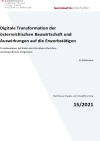
In einer Trendanalyse werden wahrscheinliche Auswirkungen der digitalen Transformation in der österreichischen Bauwirtschaft auf den Branchen-Arbeitsmarkt untersucht. Auf Basis von Feedback von BranchenexpertInnen wird für die kommenden fünf bis zehn Jahre analysiert, für welche Berufsgruppen digitalisierungsinduzierte Effekte eher zu einer steigenden vs. sinkenden Arbeitskraftnachfrage führen.
Schriftenreihe
15/2021
H. Eichmann
Herausgeber: BMK
Deutsch, 94 Seiten
Downloads zur Publikation
Energie- und Ressourceneinsparung durch Urban Mining-Ansätze
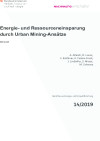
Durch die Nutzung natürlicher Ressourcen in langlebigen Produkten und Bauwerken haben sich in unseren Städten enorme Materiallager aufgebaut. Das Potential dieser urbanen Minen, zur Ressourceneffizienz moderner Städte beizutragen, wird im Rahmen des Projektes analysiert.
Schriftenreihe
14/2019
A. Allesch, D. Laner, C. Roithner, K. Fazeni-Fraisl, J. Lindorfer, S. Moser, M. Schwarz
Herausgeber: BMVIT
Deutsch, 185 Seiten
Downloads zur Publikation
Zertifizierung von Siedlungen / Quartieren
Sondierungsprojekt zur Übertragbarkeit des Schweizer Systems der 2000-Watt Arealbewertung auf Österreich
Prüfstand für energieeffiziente Automation und Regelung von Gebäuden
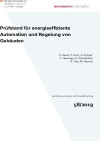
Der mit dem Planungsstand errechnete Energiebedarf deckt sich oft nicht mit den gemessenen Werten des Betriebs. In diesem Projekt werden Automation und Regelung auf den Prüfstand gestellt und eine Lösung zur Bewertung der Energieeffizienz von Regelstrategien in den Bereichen Raumlufttechnik, Betonkernaktivierung und Free Cooling entwickelt, welche anhand des Bauprojekts „Post am Rochus“ validiert wird.
Schriftenreihe
58/2019
S. Hauer, P. Horn, A. Preisler, F. Heisinger, H. Schwahofer, A. Frey, M. Gassner
Herausgeber: BMVIT
Deutsch, 29 Seiten
Downloads zur Publikation
SOFC-Abwärmenutzung für Gebäude und Industrie (SOFC4City)
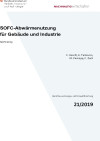
Das hohe Abwärmetemperaturniveau der SOFC-Brennstoffzelle eignet sich prinzipiell um unterschiedliche Wärme- und Stromverbraucher (Wohnbau, Industriebetriebe, ...) bedienen zu können. Ziel ist es, die Abwärme der Brennstoffzelle auf mehreren Temperaturniveaus zur Verfügung zu stellen, um so die Vorteile der Brennstoffzelle besser zu nutzen und den Einsatz für den städtischen Bereich zu prüfen. Einerseits werden die rechtlichen und marktwirtschaftlichen Rahmenbedingungen dazu erhoben, anderseits wird die technische Ausführbarkeit mittels CFD-Simulationen der Wärmeauskopplung sondiert.
Schriftenreihe
21/2019
C. Heschl, E. Terkovics, M. Peinsipp, F. Zach
Herausgeber: BMVIT
Deutsch, 88 Seiten
Downloads zur Publikation
Smart-City-Governance-Prozesse in kleinen und mittleren Städten (SPRINKLE)
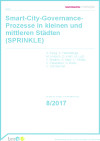
Schriftenreihe
8/2017
S. Essig, A. Hamedinger, M. Kintisch, S. Kretz, M. Lutz, V. Madner, S. Mayr, U. Mollay, K. Parapatics, S. Raho, C. Schremmer
Herausgeber: BMVIT
Deutsch
Downloads zur Publikation
OWA+Quartier - Nachhaltige Sanierung und Energieversorgung für das denkmalgeschützte Otto-Wagner-Areal Richtung Plus-Energie-Quartier
Entwicklung thermischer und elektrischer Energieversorgung für das Otto-Wagner-Areal sowie von bau- und haustechnischen Musterlösungen, um die Sanierung des Quartiers in Richtung Plus-Energie-Quartier anstoßen zu können.
OWA+Quartier - Sustainable refurbishment and energy supply for the historic Otto-Wagner-Areal towards a plus-energy district
Development of thermal and electrical energy supply for the Otto-Wagner-Areal as well as model solutions for construction and building services in order to initiate the redevelopment of the area in the direction of a plus-energy district.
DALEC - Day- and Artificial Light with Energy Calculation
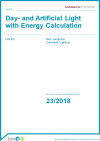
Entwicklung eines Online-Konzeptanalysetool, welches trotz einer einfachen Handhabung und kurzen Berechnungszeiten, die komplexen lichttechnischen und thermischen Vorgänge in einem Gebäude abbildet und Heiz-, Kühl- und Kunstlichtbedarf anschaulich bewertet. Zudem wurde das Nutzerverhalten berücksichtigt und visuelle und thermische Komfortkriterien analysiert.
Schriftenreihe
23/2018
Bert Junghans
Herausgeber: BMVIT
Deutsch, 41 Seiten
Downloads zur Publikation
TFlex - Temperaturflexibilisierung im Schwachlastbereich des Betriebs von Nahwärmenetzen
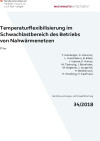
Im Zuge des Vorhabens TFlex wurde untersucht, ob sich die Netzverluste bestehender Nahwärmenetze in Schwachlastzeiten dadurch verringern lassen, indem in diesen Zeiträumen das Netz abschaltet und der Wärmebedarf der Kunden aus zuvor geladenen dezentralen Speichern bedient wird. Eine durchgängige wirtschaftliche Begleitung erlaubte es, bereits in der Projektlaufzeit technische Projekterfolge rasch in die Umsetzung zu bringen.
Schriftenreihe
34/2018
T. Kienberger, A. Hammer, L. Kriechbaum, B. Böckl, J. Vopava, K. Karner, M. Theissing, J. Bärnthaler, M. Rogetzer, J. Jungwirth, H. Biedermann, H. Strießnig, H. Kaufmann
Herausgeber: BMVIT
Deutsch, 48 Seiten
Downloads zur Publikation
Entwicklung einer praxisorientierten replizierbaren Rückbaustrategie zur Forcierung des verwertungsorientierten Rückbaus (R-Bau)
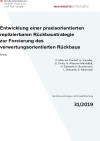
Ziel des Projekts "R-Bau" war es, unter Einbindung der relevanten Stakeholder, eine replizierbare Rückbaustrategie zur Forcierung des verwertungsorientierten Rückbaus im Wohnbau zu entwickeln. Schwerpunkte des Projekts waren die Erstellung von repräsentativen Gebäudemodellen und die Erarbeitung eines Rückbaukatalogs mit differenzierten Handlungsanweisungen. Die gewonnenen Erkenntnisse sollen auf Entwurf, Planung und Errichtung von neuen Wohnbauten angewendet werden.
Schriftenreihe
31/2019
O. Mair am Tinkhof, G. Simader, G. Trnka, N. Altmann-Mavaddat, H. Daxbeck, H. Buschmann, L. Brauneis, S. Neumayer
Herausgeber: BMVIT
Deutsch, 49 Seiten
Downloads zur Publikation
Stakeholderprozess der Initiative "Referenzarchitektur für sichere Smart Grids in Österreich"
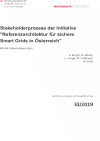
Das Projekt bereitete die Entwicklung einer Smart Grids Referenzarchitektur für Österreich unter Einbindung aller relevanten Akteure auf. Aus den technisch-wissenschaftlichen Grundlagen wurde ein Prozess erarbeitet, der die Anforderungen vom Infrastrukturbetreiber, der Industrie bis zu Bedarfsträgern abholt und zu einer national akzeptierten und international ausgerichteten Referenzarchitektur abstimmt.
Schriftenreihe
33/2019
A. Berger, M. Meisel, L. Langer, M. Litzlbauer, M. Uslar
Herausgeber: BMVIT
Deutsch, 79 Seiten
Downloads zur Publikation
PlusIQ - Agricultural Photovoltaics: Integration as a Path to Plus-Energy-Quarters
This project examines opportunities, potentials and requirements of/for Agrophotovoltaic systems. Thereby, an interdisciplinary study will be conducted that integrates the major aspects of such systems holistically and from an integrative perspective. The complex interdependencies between the different aspects will be explored and described via a case study. Potential approaches toward realization will be studied and subjected to a comprehensive SWOT-analysis.
Urbaner Kältebedarf in Österreich 2030/2050
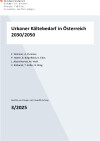
Systematische Aufarbeitung des steigenden Kühlbedarfs und Darstellung der geographischen Verortung des Kältebedarfs in Österreich. Das Ergebnis dient als Entscheidungshilfe bei der Entwicklung von Klimaschutzmaßnahmen und Klimawandelanpassungsstrategien sowie eine Abschätzung zum Kältebedarf der Zukunft.
Schriftenreihe
3/2025
F. Wimmer, A. Pummer, P. Holzer, B. Beigelböck, K. Eder, L. Abart-Heriszt, M. Wolf, C. Rzihacek, T. Keller, B. Kling
Herausgeber: BMK
Deutsch, 91 Seiten
Downloads zur Publikation
ReBuildStock - Portfolio-Management zur Dekarbonisierung großer Wohnungsbestände
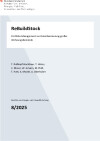
Portfolio-Managementmethode zur Unterstützung der Entscheidungsprozesse von Eigentümer:innen größerer Wohnungsbestände bei der Erarbeitung von Strategien zur schnellen und sozialverträglichen Dekarbonisierung ihrer Gebäudebestände.
Schriftenreihe
8/2025
T. Roßkopf-Nachbaur, T. Weiss, C. Moser, W. Amann, M. Ploß, T. Hatt, A. Mundt, A. Oberhuber
Herausgeber: BMK
Deutsch, 115 Seiten
Downloads zur Publikation
Urban district heating extended - Flexibilisierung und Dekarbonisierung urbaner Fernwärmesysteme
Entwicklung innovativer urbaner Fernwärmeversorgungssysteme durch Integration von Langzeitwärmespeicher, (Groß-)Wärmepumpe, solarthermische Großanlage, Abwärme und simulationstechnischer Analyse und Bewertung. Das Ergebnis dient als Vorbild für Technologieauswahl und Einsatzreihenfolge neuer urbaner Fernwärmeversorgungsgebiete.
Urban district heating extended – Development of flexible and decarbonized urban district heating systems
Development of innovative urban district heating systems by integration of long-term thermal storage, large scale heat pumps, large scale solar thermal installations, waste heat recovery and analysis and evaluation by simulation. The results of this project will provide templates for technology selection, system design and merit order for new urban district heating areas.
Innovationsachse Graz-Gleisdorf (G2G)
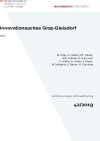
Entwicklung von Test- und Demonstrationsgebieten im Rahmen von ausgewählten Stadt(teil)entwicklungsvorhaben entlang der Innovationsachse Graz-Gleisdorf mit Fokus auf die Bereiche Energie, integrierte Gebäudetechnologien, smarter Stadtraum, kompakte Siedlungsstruktur, Nutzungsmix - Stadt der kurzen Wege, Generationenwohnen, intermodale Mobilität sowie Informations- und Kommunikationstechnologien (IKT).
Schriftenreihe
42/2019
M. Eder, K. Fallast, MT. Fallast, AM. Fulterer, B. Hammerl, K. Höfler, G. Huber, S. Maier, M. Malderle, E. Rainer, H. Schnitzer
Herausgeber: BMVIT
Deutsch, 115 Seiten
Downloads zur Publikation
P2H-Pot: Potentiale, Wirtschaftlichkeit und Systemlösungen für Power-to-Heat
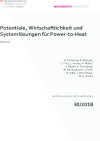
In P2H-Pot wurden die wettbewerbsfähigen Potentiale für Power-to-Heat (P2H) im urbanen Raum bestimmt. Mittels thermodynamischer Simulationen wurde die Eignung verschiedener technischer P2H Systemkonfigurationen untersucht und die Ergebnisse wurden mit Praxiserfahrungen aus Skandinavien kombiniert.
Schriftenreihe
30/2018
G. Totschnig, R. Büchele, S. Fritz, L. Kranzl, A. Müller, J. Nagler, K. Ponweiser, W. Baumgartner, J. Postl, B. Adler, J. Brandmayr, M. B. Blarke
Deutsch, 211 Seiten
Downloads zur Publikation
ENUMIS - Energetische Auswirkungen von Urban Manufacturing in der Stadt
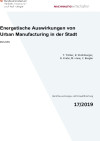
Das Projekt beleuchtet die Herausforderungen von Urban Manufacturing (UM) aus Energiesicht und zeigt Chancen auf, die sich durch eine Umsetzung von UM-Konzepten in Hinblick auf die Konzeption nachhaltiger Energiesysteme für Städte ergeben.
Schriftenreihe
17/2019
T. Tötzer, R. Stollnberger, R. Krebs, M. Haas, C. Biegler
Deutsch, 44 Seiten
